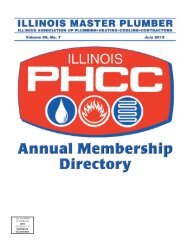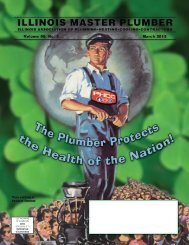MArch 22, 2013 - Illinois Plumbing Heating Cooling Contractors
MArch 22, 2013 - Illinois Plumbing Heating Cooling Contractors
MArch 22, 2013 - Illinois Plumbing Heating Cooling Contractors
Create successful ePaper yourself
Turn your PDF publications into a flip-book with our unique Google optimized e-Paper software.
ISWS Models Groundwater Flow<br />
in Northeastern <strong>Illinois</strong><br />
by Scott C. Meyer, Hydrogeologist<br />
<strong>Illinois</strong> State Water Survey, University of <strong>Illinois</strong> at Urbana-Champaign<br />
Drinking water in northeastern <strong>Illinois</strong> comes<br />
from both surface water sources (Lake Michigan<br />
and the Fox River) and groundwater. Groundwater<br />
sources include both deep and shallow aquifers. The<br />
deep aquifers are principally sandstone layers that,<br />
from the top downward, include the Ancell Unit,<br />
Ironton-Galesville Unit, and Mt. Simon Unit. The Mt.<br />
Simon is used far less than the other two deep aquifers<br />
because of the expense of drilling to it and because<br />
deeper portions contain water that is too salty for most<br />
uses. The shallow aquifers include limestone and<br />
dolomite bedrock and, above them, sand and gravel<br />
aquifers .<br />
To rationally estimate the consequences of future<br />
pumping of these aquifers, the <strong>Illinois</strong> State Water<br />
Survey has constructed a computer groundwater<br />
flow model to simulate groundwater withdrawals<br />
from them through 2050. The results of this<br />
modeling are discussed in a recent report by the<br />
ISWS: Northeastern <strong>Illinois</strong> Water Supply Planning<br />
Investigations: Opportunities and Challenges of<br />
Meeting Water Demand in Northeastern <strong>Illinois</strong><br />
(ISWS Contract Report 2012-03). The report is<br />
available for download from the ISWS web page<br />
(http://www.isws.illinois.edu/). Estimates of future<br />
pumping in the region are discussed in Regional Water<br />
Demand Scenarios for Northeastern <strong>Illinois</strong>: 2005-<br />
2050, which may be downloaded from the web page<br />
of the Chicago Metropolitan Agency for Planning<br />
(http://www.cmap.illinois.gov/). The model can be<br />
used for additional analysis of water demand in the<br />
region and as such has the potential to be a valuable<br />
tool for guiding water-supply planning efforts.<br />
The deep aquifers have long been a subject of<br />
concern for water managers. Analysis conducted<br />
by the Water Survey suggests that the deep aquifers<br />
receive too little recharge to offset the large<br />
withdrawals from wells in northeastern <strong>Illinois</strong>.This<br />
shortage of replacement water will lead to continued<br />
drawdown of the deep aquifers in the region. Model<br />
simulations discussed in the recent report suggest<br />
that partial to complete desaturation (draining of pore<br />
spaces) will affect parts of the deep aquifers by 2050.<br />
Desaturation will lead to a decline in well yields and<br />
increased pumping expenses. Deep wells in the areas<br />
of desaturation also may be vulnerable to increases<br />
in natural contaminants such as arsenic, barium, and<br />
radium,increasing the costs of treatment to protect<br />
human health. Measurement of 2007 water levels in<br />
deep wells suggests that desaturation of the Ancell<br />
Unit may already be occurring in the Joliet and Aurora<br />
areas, where deep pumping is greatest.<br />
In general, drawdown in the shallow aquifers is<br />
more scattered and of lesser magnitude than in the<br />
deep aquifers, but pumping from shallow aquifers<br />
can reduce discharge to wetlands, lakes, and streams.<br />
Model simulations suggest that natural groundwater<br />
discharge to streams in the <strong>Illinois</strong> portion of the Fox<br />
River basin has declined by 10 percent in the last<br />
century, and it may decline as much as 14 percent<br />
basin-wide by 2050 due to increased pumping of<br />
shallow groundwater .<br />
The <strong>Illinois</strong> State Water Survey has been a leader<br />
in the study of water resources for more than a<br />
century. Their research and service programs provide<br />
citizens, industries, and government agencies at all<br />
levels with timely, science- based information and<br />
analysis necessary to manage our water resources<br />
wisely for economic development and a sustainable<br />
environment. The ISWS is a Division of the Prairie<br />
Research Institute of the University of <strong>Illinois</strong> at<br />
Urbana-Champaign (U of I).<br />
<strong>Illinois</strong> Master Plumber, February <strong>2013</strong> 21





